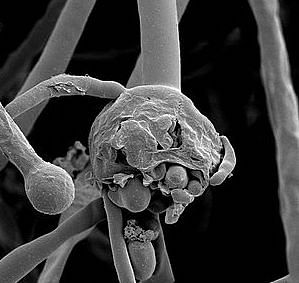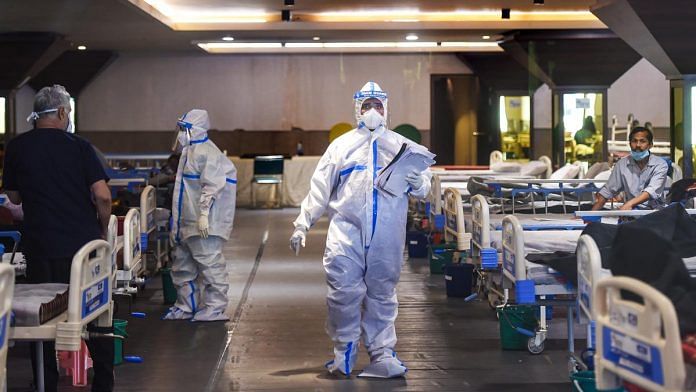India is perhaps witnessing the world’s biggest documented outbreak of mucormycosis — a fungal infection so rare that many Indian doctors with decades of medical practice experience have not witnessed more than a few cases.
A Hindustan Times report suggests that more than 7,250 cases of deadly infection have been detected in India so far, prompting the Narendra Modi government to ask states to make mucormycosis, or black fungus, a notifiable disease. A notifiable disease means the Centre has to be mandatorily informed about any case that is detected. Tuberculosis, cholera and diphtheria are some other notifiable examples in India.
This means that India is now fighting the double whammy of one epidemic nestled in the other. Ironically, the black fungus cases have been brought on primarily by the misuse of one of the proven therapies that help severe Covid patients escape death — steroids.
A misinformed and indiscriminate use of oral steroids — along with the government’s refusal to acknowledge that the healthcare system was overwhelmed, leading patients to be treated in unhygienic conditions — may have brought on this avoidable tragedy. Now, SOS messages on social media for Amphotericin B, the drug that treats mucormycosis, are slowly edging out oxygen-related posts.
That is what makes black fungus ThePrint’s Newsmaker of the Week.
Also read: Black Fungus cases rise, but Delhi’s bigger task is stocking enough medicine to treat patients
Dexamethasone use
Black fungus is a ubiquitous microbe present throughout the environment, but they cause disease only in patients whose immune systems are compromised — for example, in diabetes, cancer patients.
Symptoms of mucormycosis include pain and redness around eyes and nose, fever, headache, coughing and shortness of breath. Patients may also see blood in their vomit or from nasal discharge. The infection is often diagnosed late, and depending on the extent of the infection and comorbidities in a patient, the mortality rate can be anywhere between 30 to 70 per cent.
So, why is India seeing so many cases now? It has to do with steroids.

Dexamethasone is an oral steroid that helps dampen the overactive immune response often seen in moderate to severe Covid patients. This is one of the only drugs that has been conclusively shown to reduce mortality among Covid patients needing oxygen or ventilation, or other forms of respiratory support. However, the studies that showed its efficacy were not conducted in the kind of situation India is currently in. In the study, the drug was administered in hospital settings, where not only are hygiene standards maintained, but doctors are also available to monitor the patient’s vitals.
“While steroids are essential medicines known to reduce deaths from Covid, we want to red-flag the trend of increasing cases of mucormycosis, glaucoma and cataract in patients who were administered steroids during their Covid treatment. The majority of these patients had a history of diabetes,” Dr Digvijay Singh, head, eye department, Narayana Hospital, Gurugram told ThePrint in an earlier interview.
Also read: A cascade of rare complications is deepening India’s Covid misery
A home-made disaster
In India, the spike in Covid cases meant that hospitals were too overwhelmed to admit critical patients — leaving them and their families to fend for themselves.
Even as the oxygen shortage drove Indians to line up for cylinders or post desperate pleas for help on social media, the Modi government continued to deny shortage of hospital beds and oxygen. The time spent in issuing denials could have been better utilised on acknowledging the shortage and formulating advisories on how to manage critical patients at home.
Lack of such information led patients, state governments and volunteers to rely on incomplete information, which in turn meant that Covid-19 patients were taking drugs that lowered their body’s natural defences against the microorganisms that thrive in environments outside the ICU. Hospitals are reporting cases in wards too, with an increase in the burden of cases likely leading to critical patients being exposed to the fungus.
Indians were also administering oxygen support to the Covid-19 infected patient without knowing the appropriate hygiene practices. Sterile, distilled water is needed for humidifiers during oxygen therapies. The distilled water in the humidifiers needs to be changed daily, and must not be used past the expiry date. As hospitals ran out of beds, and doctors and nurses were pressed for time, mistakes were bound to happen.
Despite the fact that steroids should not be used outside hospital settings, some state governments distributed steroids with home isolation kits.
Elsewhere, Indians were indiscriminately popping these pills immediately after testing positive or showing symptoms of coronavirus infection. ThePrint had earlier reported how people with mild Covid were using Google as their trusted source to pop pills that should be administered only in hospital settings.
Unfortunately, the only advice given for critically ill Covid-19 patients was to get hospitalised — no advisory addressed the question of what patients were to do when hospitals were unavailable.
While the shortage of other drugs like remdesivir and tocilizumab may have initiated discussions about when they should be administered, dexamethasone remained under the radar since it is more easily available.
Then another epidemic reared its head.
Also read: Modi govt asks states to make mucormycosis a notifiable disease as cases rise across India
Increasing Covid complications
Black fungus is an expensive condition to treat, and often requires surgery to remove the moulds, which can even lead to loss of an eye.
Now that hundreds of lives have been lost to this fungal disease, Indian Council of Medical Research (ICMR) has, at last, come out with some guidelines for medical oxygen use at home. However, about steroid usage, it only says that it should be used judiciously — “correct timing, correct dose and duration”.
The Drugs Controller General of India (DCGI) has also allowed five pharma companies to make Amphotericin B.
There are already reports of other secondary infections in Covid patients in India — candida auris, or Cytomegalovirus — along with emerging cases of white fungus. The government cannot preempt such incidents, but perhaps in future, when faced with new challenges, its focus will be on keeping its citizens better informed.
Views are personal.
(Edited by Neera Majumdar)



